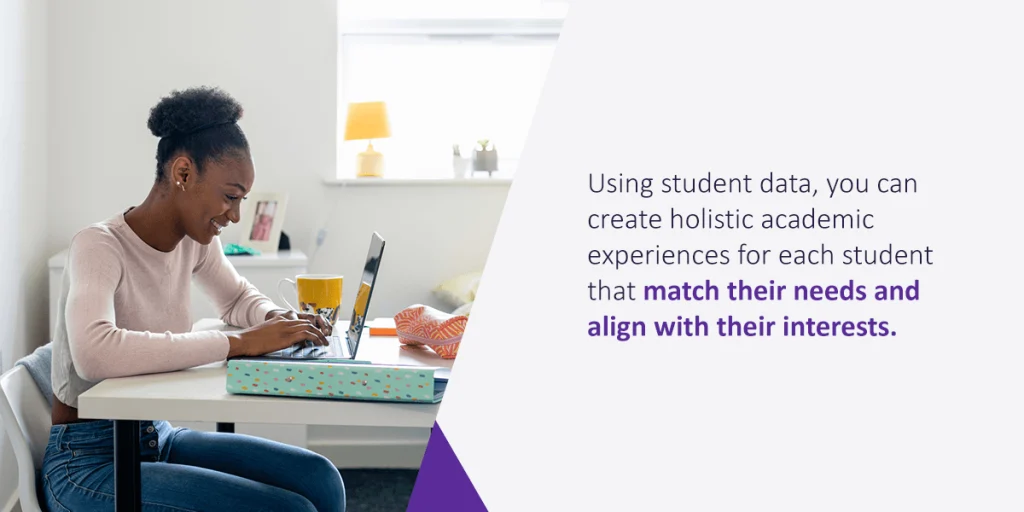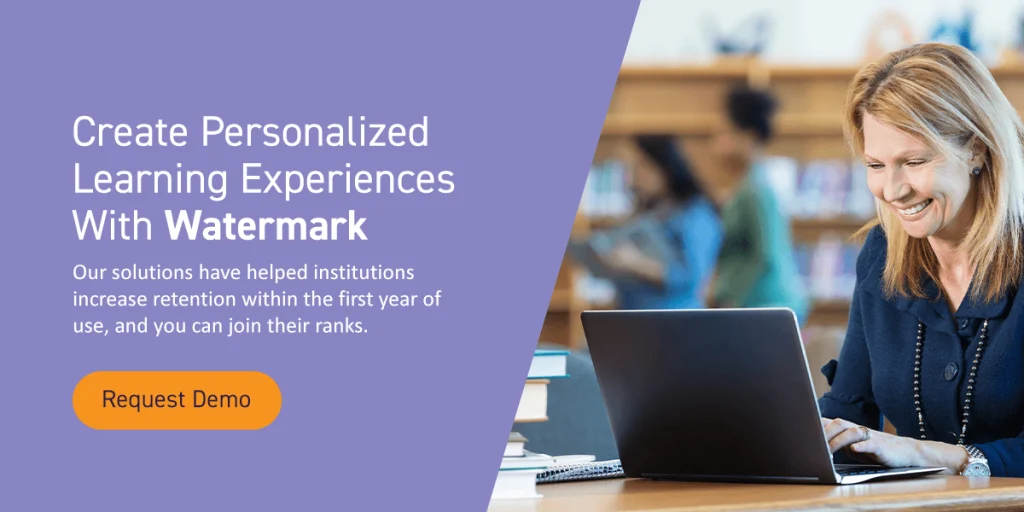Personalized learning connects students with their studies and ensures they reach success. Creating this holistic experience can keep students interested in their education, effectively increasing student retention and helping your institution achieve its goals and initiatives.
When you use student data, you receive direct feedback about what your instructors can change in the classroom. As students complete assignments, surveys, and self-assessments, you can gather information detailing how you can improve their experience. You should collect student data frequently and monitor changes in performance and behavior as your institution works to meet each student’s needs.
The Importance of Gathering Student Data
Student data helps increase achievement and awareness, enabling you to identify at-risk students early on. The more information you gather, the more data you will have to work with. You can track trends, evaluate progress, and identify pain points. Instructors can use student data to shape teaching practices, and administrators can make tenure decisions, determine promotions, and reshape curricula to fit student needs.
Student data also keeps families and the community up to date about how your institution is serving your students. High school juniors and seniors can use this information to determine whether your school will be the best fit for them or if they need to explore other options. Community members can compare your performance against other institutions and suggest ideas to improve your institution.
How to Collect Student Data
Student data is an umbrella term that encompasses many types of information, from grades to absences to course evaluations. Instructors can record this information in binders or file cabinets, written notes, or use integrative software to track it for future reflection. Administrators and educators can collect data in the following ways.
- Student reports: Students can evaluate their work and the instructor’s teaching methods. Self-assessments allow students to discuss their performance and explain their stylistic choices. Here, instructors can determine if there is a disconnect between course materials and student understanding. Student surveys and course evaluations enable learners to voice concerns about their curriculum or instructors. Additionally, students can highlight what they enjoyed about a course and whether the instruction was helpful and engaging.
- Standardized tests: Midterms and final exams are summative data that reflect group learning. This data helps determine an instructor’s effectiveness. If most students receive satisfactory grades, you know your instructors effectively communicate course materials. However, if many students fail these exams, instructors must reevaluate their teaching methods.
- Formative data: Small quizzes, question-and-answer practices, and class participation can give instructors another form of data. Using these methods, educators can determine whether students understand course materials and decide how to move forward. When all students absorb the material, the educator can continue progressing through the content, but if many people ask for more clarification, instructors can adjust the course schedule to reflect the time they need to spend explaining or revisiting information.
- Observational data: Behavior can depict student understanding and engagement. The way a student acts when instructors move around the rooms, stand in one place, have one-on-one conversations, and ask questions details whether students are engaged or disconnected. Though this method can be inconsistent, it can give instructors insight into which students need more assistance.
How to Use Student Data to Personalize Coursework
When instructors use student data to drive instructions, working collaboratively with all institution members is essential to find the best solutions. When your administrators and instructors join forces, your students benefit. Using student data, you can create holistic academic experiences for each student that match their needs and align with their interests.

Finding Integrative Software
One of the first steps your institution should take is to find integrative software that makes this transition easy and manageable. Tools like Watermark Student Success & Engagement turn existing data into actionable insights. You can gather student data, review it via customizable reports, and share this information seamlessly with your team. You will receive alerts when a student falls off track, enabling you to connect quickly with them and provide the resources they need to succeed. This software is readily accessible, simple to use, and provides consistent data to give your institution a competitive advantage when supporting your students.
Providing Workshops
Professional development workshops and other training opportunities can show instructors how to collect and use data effectively. These workshops provide educators with the tools they need to analyze data and implement changes in the classroom. Hosting consistent check-ins can keep your faculty and staff on track and foster a data-driven culture. This practice can also create accountability and collaboration opportunities that highlight new perspectives and ideas, leading your team to find the best possible solution.
Setting Goals and Identifying Gaps
When you begin tracking student data, note when data sets would be the most useful and what you hope to find. Each survey, test, project, and self-assessment should have a clear purpose to eliminate confusion or cognitive bias. Once you’ve obtained your data, you should analyze the gaps you notice. Those are where you’ll find opportunities for change. For example, you may find students perform better on tests earlier in the week or realize first-year students are not reaching institutional standards in their core classes.
Turning Insights Into Action
After identifying gaps, instructors should reshape their lesson plans and curriculum accordingly. Educators should reduce skill deficiencies and develop more effective teaching practices. As instructors make adjustments in the classroom, you must continue tracking progress to determine whether these changes are meeting student needs. Students who need additional assistance should receive more resources to keep them on track. Meetings, collaboration, and one-on-one conversations can personalize their educational path and ensure each student meets their goals.
Benefits of Personalized Coursework
Many higher education institutions are switching to personalized coursework because this approach is much more engaging for students. When you enable students to personalize their academic path, you give them an active hand in shaping their education, creating a holistic experience that increases student involvement and retention.
Consider these advantages of personalized coursework.
- Motivating students: When learners can shape their education, they’re more likely to feel intrinsic motivation. Intrinsic motivation encourages students to perform better because they enjoy the outcome of their efforts.
- Improving knowledge retention: Personalized education creates a straightforward path to success. Students can better recall existing knowledge as they apply their experiences to other courses and information, strengthening the link between the student and their education.
- Improving learning outcomes: Regardless of their starting point, students who experience personalized learning show improved achievement levels. Learners who gain better rewards for their efforts feel more satisfied with their education.
- Encouraging students to learn from each other: Though students are pursuing individual pathways, they can team up to share their knowledge. This overlap encourages peer review and collaboration, encouraging students to connect with new ideas and perspectives.
Create Personalized Learning Experiences With Watermark
At Watermark, we know data drives change, and insights inspire progress. For the last 20 years, we’ve been helping higher ed institutions use data to make meaningful changes for their students. Our solutions have helped institutions increase retention within the first year of use, and you can join their ranks.
Watermark Student Success & Engagement makes it easy to collect student data. With simplified attendance tracking, guided student pathways, and alerts when students fall off track, you can easily monitor student progress and create personalized learning experiences. Request a demo today and see what we can do for your institution.


















































































































































































































































































































































































































